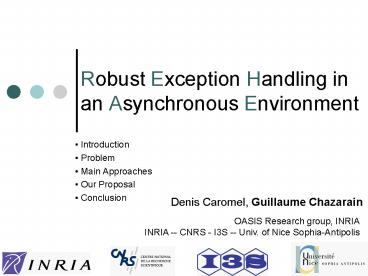Robust Exception Handling in an Asynchronous Environment - PowerPoint PPT Presentation
Title:
Robust Exception Handling in an Asynchronous Environment
Description:
ECOOP 2005 Workshop on Exception Handling in Object-Oriented Systems - July 25, ... (JR, NFE, Kava, ARMI) Drawbacks. Benefits. Solution ... – PowerPoint PPT presentation
Number of Views:29
Avg rating:3.0/5.0
Title: Robust Exception Handling in an Asynchronous Environment
1
Robust Exception Handling in an Asynchronous
Environment
- Introduction
- Problem
- Main Approaches
- Our Proposal
- Conclusion
- Denis Caromel, Guillaume Chazarain
OASIS Research group, INRIA INRIA -- CNRS - I3S
-- Univ. of Nice Sophia-Antipolis
2
Context ProActive
Introduction - Problem - Main Approaches - Our
Proposal - Conclusion
- Free (LGPL) Java library for distributed
computing - Asynchronous method calls on active objects
- Method calls like RMI/RPC
- Execution goes on
- Returns a Future object, placeholder for the
result - Transparent wait-by-necessity upon access
res1 ao1.foo1(...) res2 ao2.foo2(...) res
res1.bar(...)
Asynchronous gt Asynchronous
gt Wait-by-necessity gt
3
Incompatibilities with exceptions
Introduction - Problem - Main Approaches - Our
Proposal - Conclusion
- Exceptions are tied to synchronism
- Based on stack unwinding
- With asynchronism, the stack state cannot be
relied upon
// foo1 and foo2 may // throw exceptions try
res1 ao1.foo1(param1) res2
ao2.foo2(param2) catch (AnException e)
// Error handling res res1.foo(res2)
- Previous solution synchronously handle every
call that could throw an exception - Our contribution maintain asynchronism even with
exceptions
4
Main Existing Approaches
Introduction - Problem - Main Approaches - Our
Proposal - Conclusion
Solution Example Benefits Drawbacks
Callback (JR, NFE, Kava, ARMI) class MyExcHandler void handle(Exc e) . . . Easy Generic behaviour Incomplete context capture Unwinding impossible Limited continuation
Exception in the future (Mandala/RAMI, Java 1.5, ARMI) try future asyncCall() catch (Exc e) future.useIt() Built upon a real exception handling mechanism Exceptions thrown in an unpredictable way, outside of the catch scope
5
Our Proposal Barriers
Introduction - Problem - Main Approaches - Our
Proposal - Conclusion
- Exception in the future with a barrier at the end
of the block - The exception is thrown upon access to the future
- Before leaving the block, we wait for every
associated call to return - Calls with compatible exception types
- Guarantee that the exception is thrown in the
right block
6
Main API
Introduction - Problem - Main Approaches - Our
Proposal - Conclusion
- tryWithCatch
- Pushes the exception mask
// foo1 and foo2 may // throw exceptions tryWithCa
tch(AnException.class) try res1
ao1.foo1(param1) res2 ao2.foo2(param2)
endTryWithCatch() catch (AnException e)
// Error handling finally
removeTryWithCatch() res res1.foo(res2)
- endTryWithCatch
- Waits for the calls
- Pops the exception mask
- removeTryWithCatch
- Fixes the stack
7
Entry Barrier
Introduction - Problem - Main Approaches - Our
Proposal - Conclusion
- Nested blocks
class MyException extends Exception try A
a ro.foo() // throws MyException / Barrier
here / try a.bar() // throws
MyException catch (MyException e)
// a.bar() error handling // Without
the barrier, the ro.foo() //
exception would be handled here catch
(MyException e) // ro.foo() error
handling
- The exception will be handled in the surrounding
block, not the nested one
8
Asynchronism Consequences
Introduction - Problem - Main Approaches - Our
Proposal - Conclusion
- Illegal consecutive calls
- Throw the exception as soon as possible?
- No unpredictable behaviour
- We rely on the wait-by-necessity
// foo1 and foo2 may // throw exceptions try
res1 ao1.foo1(param1) res2
ao2.foo2(param2) catch (AnException e)
// Error handling res res1.foo(res2)
- Consecutives exceptions
- With synchronism only the first one
- We only keep the first one
9
Stacks inconsistencies
Introduction - Problem - Main Approaches - Our
Proposal - Conclusion
// foo1 and foo2 may // throw exceptions tryWithCa
tch(AnException.class) try res1
ao1.foo1(param1) res2 ao2.foo2(param2)
endTryWithCatch() catch (AnException e)
// Error handling finally
removeTryWithCatch()
Ex.class
Ex.class
Java stack
Emulated stack
- No information as to when an exception is thrown
- The emulated stack is corrupt
- Fix in the finally block
10
Conclusion
Introduction - Problem - Main Approaches - Our
Proposal - Conclusion
- Existing mechanisms too limited
- Asynchronous calls with exceptions
- Looses some asynchronism
- In practice the synchronism comes from the
wait-by-necessity, not the barrier - Other techniques are being considered
- Checkpointing to cancel illegal calls































